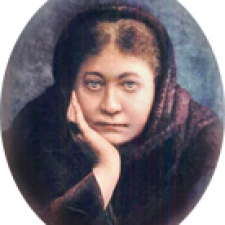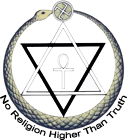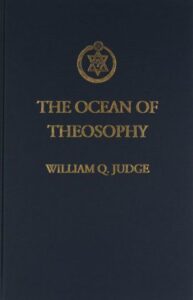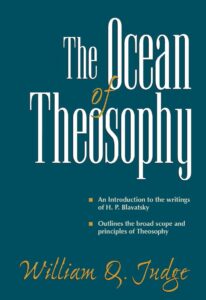Studies In The Ocean of Theosophy Part XXXII
Theosophy Magazine
Vol. 23, No. 8 June 1935
pages 369 - 372
Part XXXII
CHAPTER fifteen is a word-picture of the processes taught in the Third Fundamental Proposition of the Secret Doctrine — a dramatization of Evolution and the brotherly reciprocity necessary for souls on their “obligatory pilgrimage.” The parts delineated represent intelligences ranging all the way from that in elementary forms to the illumination of a “Dhyani-Buddha;” for the very least of lives, being essentially a “purely spiritual Buddhi,” is potentially a “divine Soul,” evolving under the same laws as the highest. The human being represents the acquiring of “an independent (conscious) existence” by the monad’s passing “through every elemental form of the phenomenal world” of this Manvantara; the “spark” has ascended “through all the degrees of intelligence,” from “mineral and plant,” up to individualization, thence to whatever degree of Manasic unfoldment may have been gained “by self-induced and self-devised efforts.” The lay-majority of mankind, consisting of units identified with their bodies, altogether incognizant of their true identity, is still subject to the “Cycle of Incarnation (or ‘Necessity’) in accordance with Cyclic and Karmic law.”
The Heroes of this drama are They who have broken self-identification with objectivity, and yet sacrifice Their dearly gained freedom for the sake of those still held in bondage. Their Cycle of Necessity transcended, these Christs of Compassion voluntarily suffer the crucifixion of re-incarnation, “to help and teach others.”
Each kingdom below the human is constituted of sparks not yet individualized — in many gradations of class consciousness. But, intelligence being innate throughout the vast Whole, the lives in all kingdoms are responsive to stimulus from those aware of self-hood. This response is known as “natural impulse,” the quality of which depends upon the character of the impelling influences. Thus great Nature is elevated, retarded, or thrown back in her evolution by human thought and feeling. So definitely do Man’s mental and psychic natures impress and color the life expressions in mineral, plant, and animal, that these become virtually his reflections.
The “chain is complete from lowest to highest being, the whole purpose of the Universe being the evolution of Soul.” But Soul evolution having no ultimate termination, always unknown reaches stretch ahead; no elevation is so lofty as to preclude “Universal Brotherhood.” No one goes this way alone, since all are fundamentally identical “with the Universal Over-Soul.” All are emanations from the same source and are striving towards a common goal, with a common purpose, and subject to the same processes. The means, it is true, must vary with the pilgrim’s individual efforts, “self-induced and self-devised;” but, however wise and practical these efforts, they are not sufficient. Neither are they for individual benefit solely. The Law of Brotherhood, inherent and immutable, entails the transmission of all knowledge gained, no matter how lowly the transmitter. Just so it demands that the “higher degrees of consciousness work in, through and upon the lower, thus impelling them in the direction of the higher.” Beings on any rung of the Ladder of Evolution are in duty bound to reach the helping hand to those below, while at the same time receiving assistance themselves from more evolved Entities. Yet, in this interchange of service, sometimes the lesser teach the greater; all are teachers and all are learners where mutual efforts are put forth.
Our planetary drama is cast in seven major acts. The first three and one-half of these are almost inconceivable to us of to-day, so prone to regard all manifestation from this physical-plane viewpoint. The earlier Rounds largely serve as prologue to the real enactment of the Play; nevertheless, it seems evident that even in those mysterious times the Ideal was being gradually unfolded, and that in every cycle of descent, from fiery, ethereal substance down to our concrete sphere, appropriate organs and faculties were developed for its depiction, at every stage.
Only at the middle of the fourth Round could the earth be called man-bearing. Then, with the incarnation of the Manasa Putras, the Human-Self began his great role, visibly, upon the objective stage. Throughout the prior “acts,” the influence of Manasic intelligence played upon both material evolution and the evolution of form. By means of it, matter was stimulated to form itself and the human-body matrix was drawn upward to its consummation in a new Temple of Solomon, suited to conditions here.
When our former home, now the Moon, had been “worked out,” so far as mankind was concerned, her best devices and designs — “some forms of animal life, some fruits and other products” — were “brought with the first and highest class of beings” as “models or types for us here.” But, “the general forms of the various kingdoms being so brought over” required “intelligent aid and interference,” to adapt them to their new use. This was the task of exalted Beings, in Theosophical literature “called the Dhyanis.” “By methods known to themselves and to the Great Lodge,” they worked on these patterns and, “by adding here, taking away there, and often altering,” transformed “the kingdoms of nature as well as the gradually forming gross body of man.” By thought and by employment of the image-making faculty, these Great Ones traced the lines for Earth’s evolution.
Mr. Judge barely touches on these processes, stating that they are “too far ahead of the time” to permit fuller treatment. That they are still too advanced can not be doubted. Particularity would still encounter “ridicule” or “stupidity,” even if it did not arouse superstition — perchance, some idea of witchcraft affecting the lower kingdoms and casting its spell upon the human form in some weird rites of plastic surgery. For nothing is too ridiculous for materialism and prejudice to conjure against the possibility of unfamiliar and subtle aspects of Nature!
If there were no substance other than that presently perceived by us, repudiation of these teachings outright would be proper. But when the existence of an inter-penetrating, astral substance is introduced into the discussion, it takes on a very different hue. For the work of the Dhyanis was “carried on chiefly in the purely astral period preceding the gross physical stage.” The termination of this purely astral state — “about 300,000,000 years” in length — marked “the midway point of evolution,” when the incarnation of the self-conscious beings, so mighty was the impact of their force, precipitated physical matter. In such wise, the seven Great Races of Man made formal entrance upon this plane of being, each clothed in its properly appointed seven-fold costume, again to enact the planetary drama on a better stage.
The teachings of Continuity and of Cyclic Law show that existence represents an endless succession of dramas, while the theme of brotherly service running through all consists of two chief movements — the ascending and the descending lines of evolution. The vast span “passed by earth and man and all the kingdoms of nature in an astral stage” on this planet was the last step for both these streams of evolving lives, before the formation of “gross matter such as we now know.” It was the last step up for the rising tide and the last step down for the descending tide. With the eventual hardening process, in which the form of man “was first to become solid,” the action of the epic Mahabharata (Great War) began its play of inspiration and despondency, battle and peace, hope and despair, tragedy, and even comedy, as true Brotherhood wages its struggle against personal selfishness. In some scenes, the stage lights burn bright, in others dim. Often, shadows creep or total darkness falls. Some parts are poorly rendered, some well. And many times the Original Lines of the Great Playwrights suffer interpolations that mar the plot and defeat its purpose.
Yet, regardless of success or its lack, the immortal Actor, urged on by his own innate energies, ever seeks for further self-expression. Every gain forms the foundation for fresh effort; every failure starts the climb anew. So with the Moon dwellers: when they awoke from their inter-planetary recess, it was to pick up old lines in new places. Earth meant but another beginning, in furtherance of what had been formerly portrayed. “The varieties of character and capacity which subsequently appear in man’s history are the forthcoming of the variations which were induced in the Egos in other and long anterior periods of evolution upon other chains of globes,” of which the Moon chain was but one. And these variations, “so deeply impacted as to be equivalent to inherent characteristics,” form the natural channels along which the evolutionary forces presently flow.
Economy is a fiat of Nature. Applied to the matter of obligatory incarnation, it may be seen how the very “unfinished business” left by the average man at death establishes a cycle of necessity that conserves the needs of the lower kingdoms. If re-incarnation, with its forced payment of debts, were left to selfish individual choice, there might be many absentees. Now, the cycle of re-embodiment requires materials drawn from the earth, water, fire, and air of the planetary substances; in thus furnishing the needed fleshly raiment, the constituent lives of these elements are brought into direct contact with self-conscious intelligences. Albeit the impressions received in this way are sometimes far from desirable, they nevertheless bring experience, which is better than no experience. Also, there is a Monitor abiding in the heart of every human being. Sooner or later, the thinking entity is “checked by its Karma” and moved to listen to the still, small voice within, speaking for the cause of righteousness and duty. Sometime every man must discard false acting and undertake his legitimate role of helper and friend, seeking to “render gentle service to all that lives.”
Back to The Ocean of Theosophy



